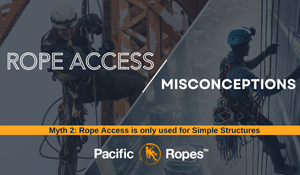The two rope access certifications utilized the most here in North America are SPRAT (Society of Professional Rope Access Technicians) and IRATA (Industrial Rope Access Trade Association).
While SPRAT is mostly recognized in North America, IRATA is an internationally recognized certification. If a client requests an IRATA certified technician (and this is beginning to happen more frequently), a SPRAT technician will be unemployable for that job. This is because IRATA companies can only employ IRATA certified technicians according to the IRATA standards (ICOP).
To help circumvent this, IRATA has created a SPRAT to IRATA conversion procedure which gives experienced SPRAT technicians the opportunity to earn an equivalent level certification with IRATA.
Previously, if you’ve ever held an IRATA certification (even if it’s expired) you are not eligible for this process. However, new regulation has come into effect now to dissolve this restriction so that technicians that meet the requirements below, can apply for their SPRAT to IRATA conversions; regardless of whether or not they have held an IRATA certification.
What are the pre-requisites for the SPRAT to IRATA Conversion?
The conversion procedure is a little different, depending on your level of SPRAT certification. To make this easy, find the scenario that fits you the most from the six options listed below and then proceed from there.
*Hours completed at each SPRAT level must be properly documented in your SPRAT log book before your certification can be considered for conversion. Falsifying records, experience, and hours is prohibited and can prevent you from permanently obtaining any IRATA certification.
1. You’re a current SPRAT L1.
- You will follow the normal entry route to IRATA certification
- You will have to complete a 4-day (minimum length) training course with an IRATA Training Member Company (like us).
- Followed by a level 1 IRATA independent assessment.
- If successfully completed, you will receive an IRATA L1 certification.
2. You’re a SPRAT L2 and have 1000 hours of SPRAT L2 experience, logged over a minimum of one year.
- You will have to complete a 4-day (minimum length) IRATA L2 training course with an IRATA Training Member Company (like us).
- Followed by an IRATA independent assessment. For the SPRAT to IRATA conversion students, you'll need to successfully complete ALL IRATA L2 maneuvers. In other words, you need to complete everything in the white and grey boxes on the IRATA assessment form.
- If successfully completed, you will receive an IRATA L2 certification.
3. You’re a SPRAT L2 but have logged less than 1000 hours and/or have less than one year of experience working with L2 certification.
- You have two options.
- You can take the 4-day IRATA L1 training and assessment and proceed to take your IRATA L2 once you have 1000 hours and 1-year experience as a SPRAT L2.
- You can wait until you’ve completed your SPRAT L2 1000 hours and one year of experience before applying for your IRATA L2 conversion – because, for option 1, you will have to pay for two training courses (IRATA L1 and eventually IRATA L2), this is the more economical option if it’s a possibility for you.
4. You’re a SPRAT L3 and have 1000 hours of SPRAT L3 experience, logged over a minimum of one year.
- You will have to complete a 4-day (minimum length) IRATA L3 training course with an IRATA Training Member Company (like us).
- Followed by an IRATA independent assessment. For the SPRAT to IRATA conversion students, you'll need to successfully complete ALL IRATA L3 maneuvers. In other words, you need to complete everything in the white and grey boxes on the IRATA assessment form.
- If successfully completed, you will receive an IRATA L3 certification.
5. You’re a SPRAT L3 but have logged less than 1000 hours and/or have less than one year of experience working with SPRAT L3 certification.
- You have three options.
- You can take the 4-day IRATA L1 training and assessment and proceed to take your IRATA L3 once you have 1000 hours and 1-year experience as a SPRAT L3.
- Provided you have a minimum of 1,500 logged hours from your experience as a SPRAT L1 & L2 technician, you can apply to have your SPRAT L3 certification converted to IRATA L2.
- You can wait until you’ve completed your SPRAT L3 1000 hours and one year of experience as a SPRAT L3 before applying for your IRATA L3 conversion– because, for both of the above options, you will have to pay for two or three training courses (L2 and eventually L3), this is the more economical option if it’s a possibility for you.
How do I apply for my SPRAT to IRATA conversion?
- All SPRAT to IRATA conversions need to be approved by the IRATA Head Office. We will help submit your application to IRATA. Once approved, we can then schedule your IRATA training.
- You will need to submit the following information to us:
- Your full name
- Your application fee (contact us for current rate)
- Current SPRAT certificate showing both registration and expiry date
- A copy of your SPRAT ID card showing expiry date
- A copy of your SPRAT logbook showing all relevant hours as per your qualifications
What should I bring to the training and assessment for my SPRAT to IRATA conversion?
- Your IRATA approval letter
- Your valid SPRAT ID card, SPRAT certificate and logbook. Your log book must have all of your hours properly logged. This will be checked. No training or Assessment can take place unless both the SPRAT card and completed SPRAT logbook are presented.
- You must have a copy of the IRATA ICOP, the IRATA TACS, and the IRATA TMC Training Manual. This will be provided to you on the first day of training.
What happens if I don’t pass my IRATA assessment?
- You may have the option of retaking the assessment once (this option will be at the discretion of your assessor). You can not take any assessment more than twice.
- If you are a SPRAT L3 technician and are unsuccessful in your conversion to IRATA L3, you may still be able to secure an IRATA L1 or L2 certification. This same scenario is true for a SPRAT L2 technician, who may be able to secure an IRATA L1 certification. In both cases, this will be up to your assessor.
How much does this cost?
- You will need to pay the current course fee plus the application fee for the SPRAT to IRATA conversion. To find out the current rates, please email us below or send us a message through chat!
Ready to Register? Click below!



